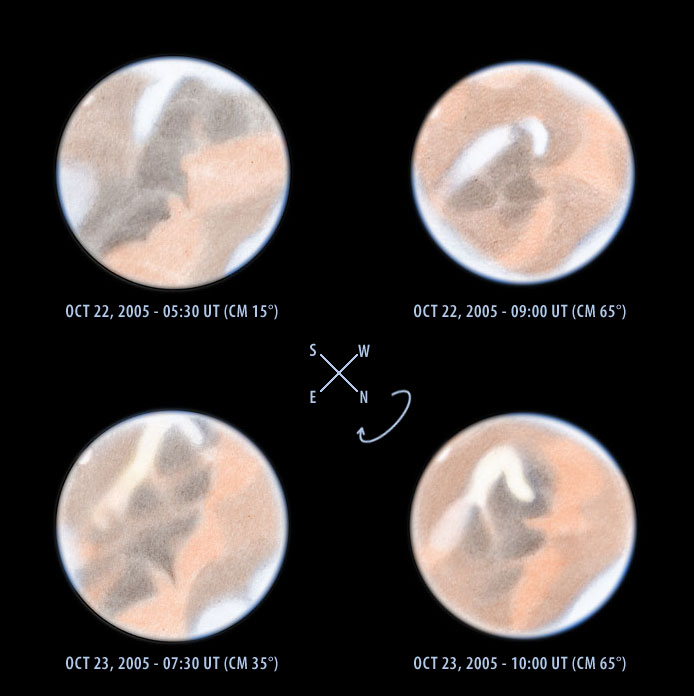2005 Martian Dust Storm
In late October during the 2005 Martian apparition, a dust storm
began to roar across the planet’s southern hemisphere. Over the
course of two nights, I was able to make four sketches of the storm
as it developed and rotated into view.
In the sketches, the dust storm can be seen wrapping out of the Solis
Lacus region. On the first evening, I was not able to detect any
color in the storm, but on the second evening, I thought I could
discern a very subtle, yellowish tint. I supplemented the
observations with 21A Orange and 80A Blue filters while using a 6″ f/
8 Newtonian at 240X magnification.
The sketches were made with 2H and HB pencils on 28# bond within 2.5″
diameter circles. For each sketch, I began by completely shading one
circle very lightly with a 2H pencil and then blending with a
blending stump. Then, using both unfiltered and 21A filtered views, I
shaded darker albedo regions with the HB pencil and blended again
with the blending stump. I described bright regions by using both art
gum and kneaded erasers to remove the base shading.
I made a second sketch of each view while using a 80A Blue filter.
This supplementary sketch consisted of a simple line drawing denoting
the brighter areas I saw.
After scanning the sketches and adjusting for contrast, I applied a
black background with a slightly blurred edge to approximate the soft
view through the eyepiece. By using additional layers in Adobe
Photoshop, I added color over the pencil drawing as described in my
notes. Where the 80A line drawing indicated bright spots, I added
some blue to the boundaries of those areas to show that they were
strong in blue light.
Jeremy Perez
http://beltofvenus.perezmedia.net


I have been admiring your Mars sketches for some time now and I’m impressed at just how well you have ‘nailed’ the pinky salmon colour of the planet. That is just how I see it, but I struggle to duplicate it in my own drawings. Is this colour from a single pencil or of some combination? I also applaud your use of blurring to add to the realism. When I sketch something that looks sharper than what I see, I feel like I’m cheating or something–so I add a little blur to get it to where that feeling goes away. Should “guilt” be part of sketcher’s aesthetics?
Hi Gerry,
I don’t know about sketchers in general, but guilt is certainly one of my lingering nemeses (nemesises?). I even have ongoing guilt that I use Photoshop to add color and blur the edge of the disc of these planetary sketches rather than managing that directly on the paper with colored pencils, pastels and TLC.
Which sort of begins to answer your original question about how the color is added. The sketch begins as a completely colorless pencil sketch. When making my first sketches of Mars, I made an effort to come right inside and try to match what I saw visually with the color mixer in Photoshop. I used that as my basis for color in future observations and made the colors more or less saturated depending on how things looked on any given night.
Here’s hoping for some more fun with the 2007 apparition.
Jeremy
Jeremy,
In these sketches you have truly captured Mars from Earth. Your attention to detail both added and subtracted and your design of the correct steps to take really pays off in the end.
I would call these sketches subtly extraordinary.
Frank
Jeremy, until I can afford the Heisenberg pencils with the adjustable Plank’s constant, I will continue to use the compooter to blur my sketches to approximate what I see. Sketching still seems to be the best way to convey to others what we see at the eyepiece and that is why I appreciate it so much. It is interesting that much of the original impetus for sketching was to overcome seeing conditions that thwarted film imaging. Now that digital imaging has largely overcome that problem, sketching is being released from that task to become something more “artistic” and “impressionistic” and not necessarily directed towards “realism”. Now I hesitate to use those words found in quotes in that last sentence as they are so poorly defined. But while I have no objections to sketching moving into new areas, I will still consider the goal of sketching to be to represent what I see through the eyepiece as accurately as possible. Hopefully the finished product will be close to what is found “on the paper”.